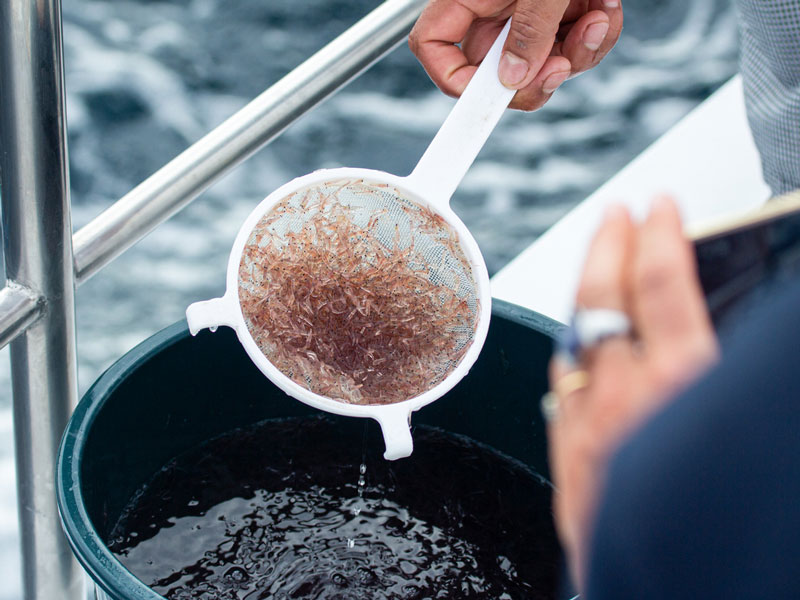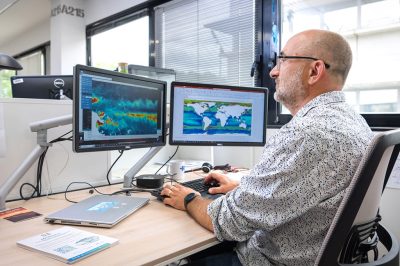CLS Develops a New Numerical Model to Study Krill in Antarctica
- 25 September 2023
- Category: News

In collaboration with David Green from the University of Tasmania, CLS is developing a new numerical model to study krill in Antarctica.
Antarctic krill (krill) are small crustaceans that are restricted to the Southern Ocean, where they occur at enormous biomasses (~400 Mt). Being so numerous, krill form a crucial part of many Southern Ocean food webs, supporting massive populations of fish, whales, seals, and penguins, as well as a developed fishery.
However, despite being so important, we still have a lot to learn about the environmental processes that affect krill’s biomass and distribution. One of the challenges is that krill has a complex life cycle with different developmental stages having distinct habitat requirements. For example, some stages are highly dependent on sea ice concentration, while others are not. This makes it difficult for us to predict how krill populations could be affected by a changing environment.
SEAPODYM, the genesis of the model
SEAPODYM is a CLS product, co-own with the Pacific Community, a general modeling framework for the population dynamics of marine organisms.
We have developed 2 applications of this model: for micronekton and for predators (tuna). Krill lies between these 2 models, giving us a third application. The migratory aspect of tuna is not present in krill, and on the contrary, krill evolves in a zone with its own specificities, such as ice.
An international collaboration
The model developed for krill (KRILLPODYM) simulates various aspects of krill behavior and distribution in Antarctica. Scientists can use environmental data such as water temperature, sea-ice concentration, ocean currents and food availability to create predictive models of krill distribution. These models can also take into account interactions with other marine species and changing climatic conditions.

David Green, Postdoctoral Research Associate with the Australian Centre for Excellence in Antarctic Science (ACEAS) at the University of Tasmania, first author of the scientific publication:
“I first heard about SEAPODYM during my PhD, when I was using the SEAPODYM model outputs to better understand how Southern Ocean predator (seals and penguins) foraging behaviour and success could be attributed to the availability of micronekton (prey).
Over the course of my PhD, I was fortunate to be able to twice visit (pre-COVID!) the CLS ecosystems team in Toulouse. Through discussions with the team, I came to better understand the SEAPODYM tuna model and its great potential for representing a species’ life history, habitat requirements and the spatial processes influencing its.
From that point, it seemed like an obvious choice to try to adapt SEAPODYM for representing krill! This has led to a fantastic collaboration between our teams over the last four years.”
Olivier Titaud, scientist at CLS and 2nd author of the scientific article published on the subject:
“In 2017 I was involved in a collaboration with David Green, a PhD student at the University of Tasmania, who wanted to model the krill population in Antarctica. This collaboration began by providing him with the food density data he needed to estimate some biological parameters of this species. Our collaboration was strengthened in 2022 when we decided to develop a specific model for krill based on SEAPODYM.
KRILLPODYM was born and was recently validated – the results were published in the journal Frontiers in Marine Science. My contribution has been to adapt the various SEAPODYM modules we are developing to this species.”

What will this model bring to our research?
Fish stocks evolution is difficult to predict, so it’s important to model them to anticipate potential exploitation and imagine how the stock will evolve in the event of climate change or different currents.
KRILLPODYM has great potential utility in studies that improve our understanding of krill and krill ecosystems.
As a model that generates circumpolar estimates of krill biomass, KRILLPODYM could help identify areas that should be prioritised for future sampling; particularly in Southern Ocean regions that remain poorly observed. The model also gives us capacity to test how changes in sea ice, ocean currents, temperature and food availability will affect krill populations in the coming decades. This would subsequently help us understand how environmentally driven changes to the krill population might, in turn, affect dependent predators such as whales, seals, and penguins.
Finally, because KRILLPODYM can be used to simulate krill biomass at fine resolutions, it has great potential for testing different fishing scenarios and their effects on krill abundance, and its predators, across different spatial scales. This work should provide a valuable tool for managing competition between fisheries and ecosystems.
Conclusion
This scientific publication is an important first step towards modeling this species. The development of a numerical model to study krill in Antarctica could make a significant contribution to our understanding of the Antarctic marine ecosystem, and to informed decision-making in marine resource conservation and management.
KRILLPODYM now enables us to :
- Understand krill population dynamics: Using real-time data and historical information, scientists could try to better understand fluctuations in krill populations and the factors that influence them.
- Predicting the impacts of climate change: Numerical models could be used to predict how krill populations might respond to ongoing climate changes, such as rising ocean temperatures and changes in ocean currents.
- Support marine conservation: A better understanding of krill distribution and its role in the marine ecosystem could help inform conservation decisions, ensuring that human activities do not excessively disrupt this fragile ecosystem.
- Informing fisheries management: Krill is also harvested for a variety of uses, including animal feed and dietary supplements. Accurate numerical models could help establish sustainable fishing quotas to preserve the krill population and its role in the ecosystem.
Read the scientific publication:
https://www.frontiersin.org/articles/10.3389/fmars.2023.1218003/full
